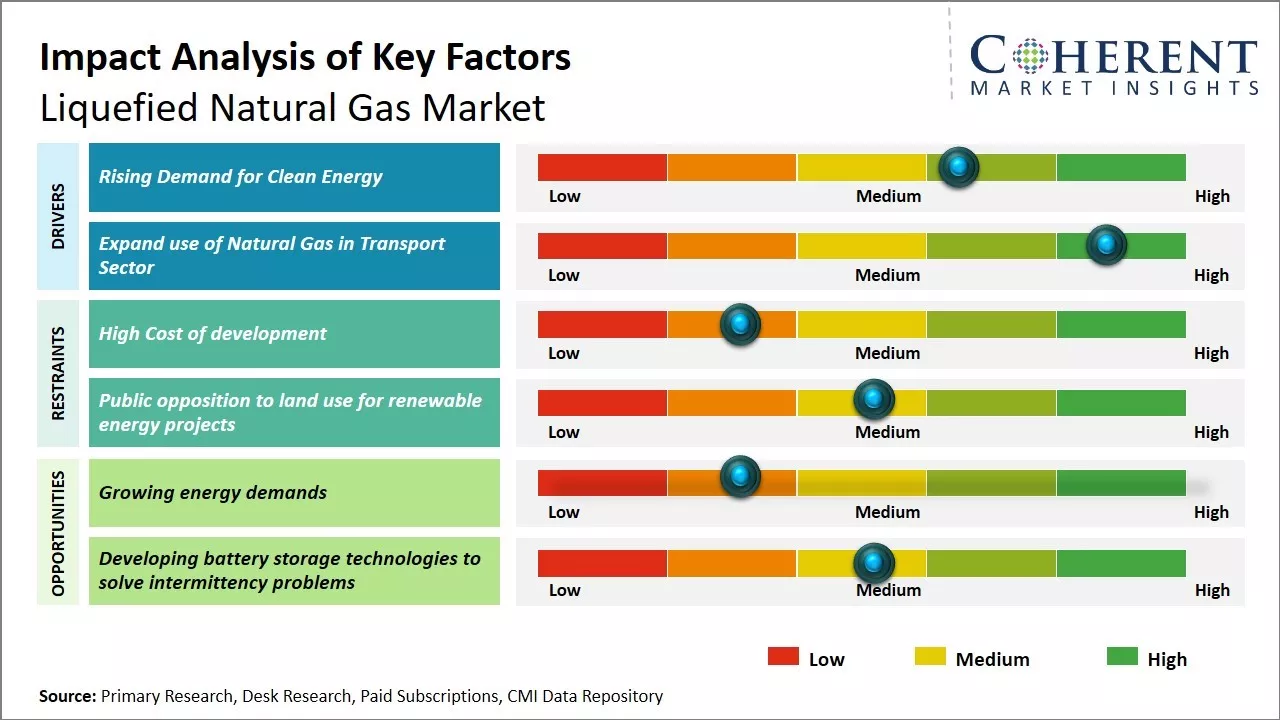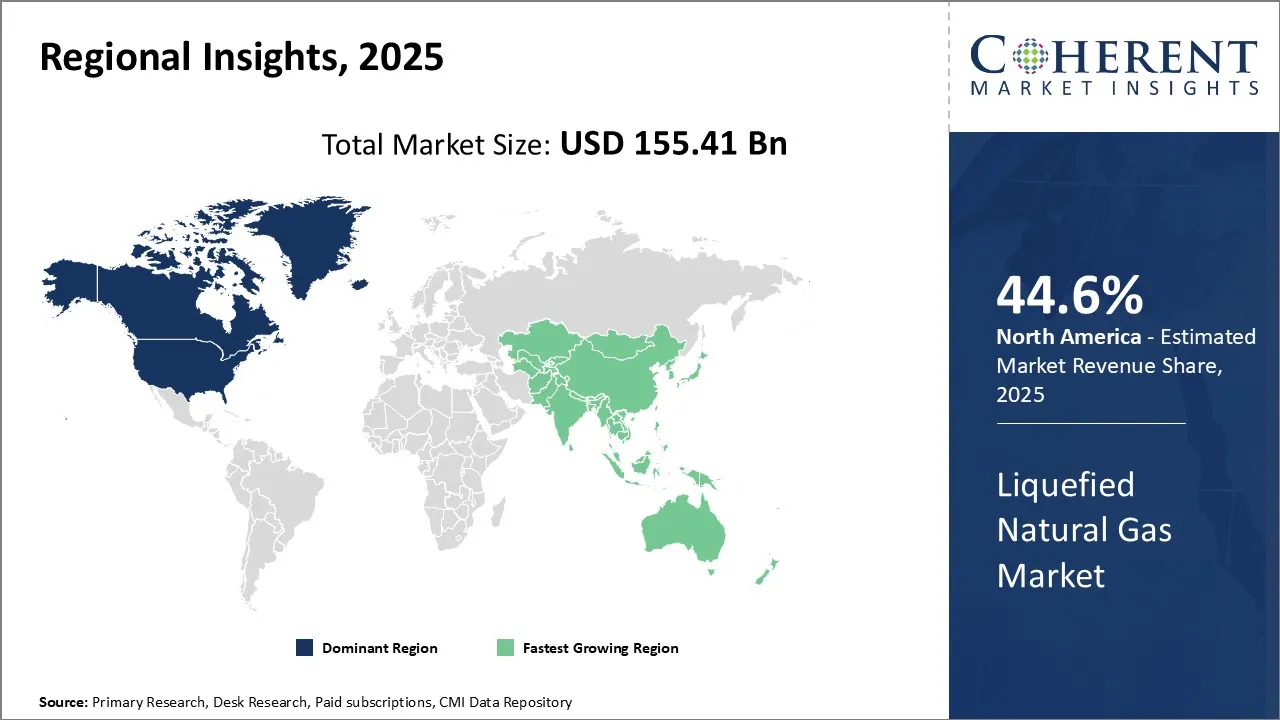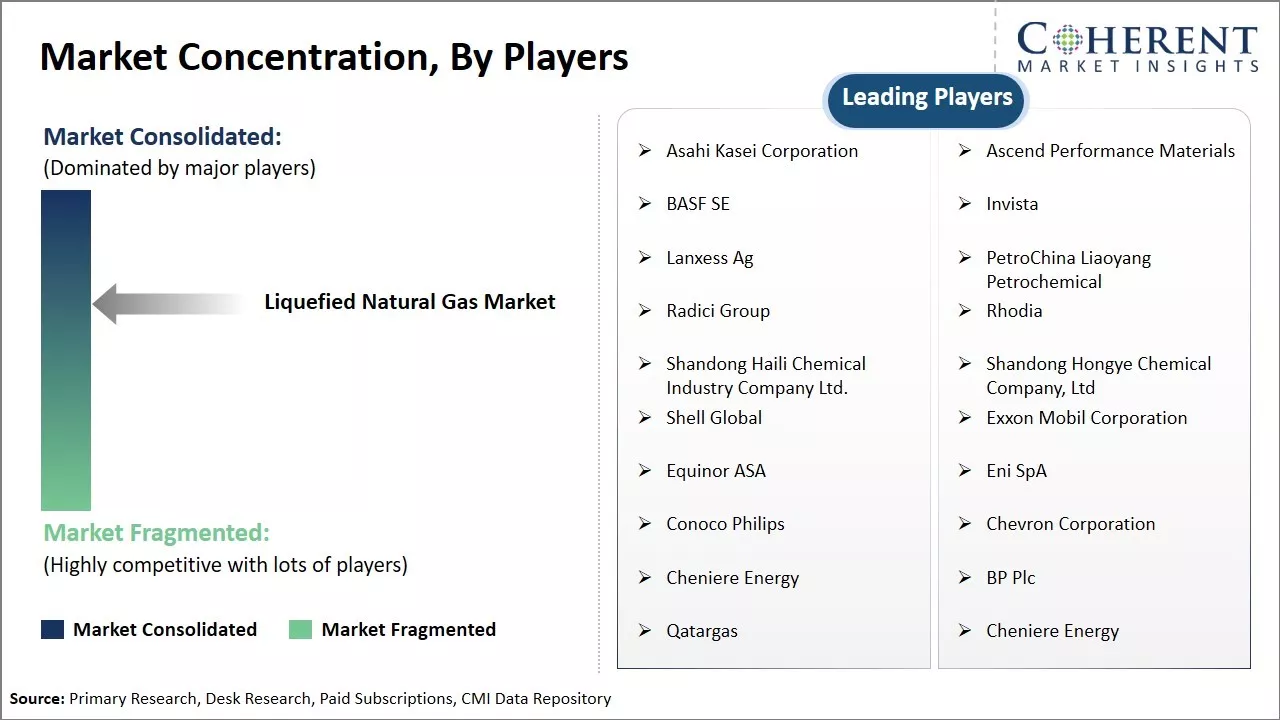The liquefied natural gas market is estimated to be valued at USD 155.41 Bn in 2025 and is expected to reach USD 289.79 Bn by 2032, growing at a compound annual growth rate (CAGR) of 9.3% from 2025 to 2032.

To learn more about this report, Download Free Sample
The liquefied natural gas market demand is growing strongly driven by rising global energy needs, environmental rules, and building new infrastructure. LNG is becoming more popular as it burns cleaner, which makes it a good fuel for power generation, transportation, and industrial uses. Asia is still an important area for growth, and technological innovation and supply diversification will shape future trends.
|
Current Event |
Description and its Impact |
|
Unprecedented North American LNG Supply Expansion (2025-2030) |
|
|
Regulatory and Environmental Compliance Evolution |
|
Uncover macros and micros vetted on 75+ parameters: Get instant access to report
|
Region/Country |
Role |
2024 Volume (MT) |
2025 Trend Highlights |
|
United States |
Exporter |
~86.0 MT |
Expanding export capacity; CP2 LNG project launched |
|
Qatar |
Exporter |
~79.0 MT |
Stable exports; long-term contracts dominate |
|
Australia |
Exporter |
~78.0 MT |
Flat growth; facing cost and domestic supply challenges |
|
Russia |
Exporter |
~32.0 MT |
Arctic LNG 2 begins exports to China |
|
Asia Pacific |
Exporter |
138.91 MT (regional total) |
Largest exporting region; added 4.10 MT over 2023 |
|
China |
Importer |
~70.0 MT |
Strong spot LNG demand; heatwaves and industrial use |
|
India |
Importer |
~26.0 MT |
Infrastructure expansion; rising industrial demand |
|
Japan |
Importer |
~62.0 MT |
Stable demand; LNG used for power and heating |
|
South Korea |
Importer |
~46.0 MT |
Moderate growth; energy security focus |
|
Europe (Total) |
Importer |
100.07 MT |
Declined by 21.22 MT from 2023; high storage and pipeline flows |
|
Brazil & Argentina |
Importer |
~10.0 MT (combined) |
Moderate growth; LNG used for power and industry |
|
Southeast Asia |
Importer |
~15.0 MT (combined est.) |
Growing demand in Vietnam, Thailand, Philippines |
Uncover macros and micros vetted on 75+ parameters: Get instant access to report
In terms of application, the power generation segment holds 54.7% share of the global LNG market, driven by rising demand for cleaner energy and declining reliance on coal. Natural gas emits half the carbon of coal, making it a key transitional fuel. Asian nations are expanding gas-fired capacity, supported by infrastructure investments and stable LNG prices. Export growth from the U.S., Australia, and Russia has improved supply reliability. Long-term contracts help power producers hedge risks. As countries pursue energy security and diversify sources, LNG remains vital for supplementing renewables and replacing retiring coal plants, ensuring its continued dominance in global power generation.
For instance, in January 2025, SK Gas inaugurated a 1.2 GW dual-fuel LNG-LPG combined cycle power plant in Ulsan, South Korea. The facility, supplied via pipeline from Korea Energy Terminal, marks a shift toward cleaner energy. Designed to power 2.8 million households, it enhances energy security and supports South Korea’s low-carbon transition.

To learn more about this report, Download Free Sample
North America has been the dominant region in the global Liquefied Natural Gas (LNG) market with 44.6% share in 2205, due to expanded export infrastructure, rising shale gas production, and strong global demand, especially from Europe and Asia seeking energy security. LNG serves as a cleaner transition fuel, supporting renewable energy integration while ensuring grid reliability. Economic growth and geopolitical leverage further amplify its strategic importance.
According to the U.S. Energy Information Administration, North America’s liquefied natural gas export capacity could rise from 11.4 to 28.7 billion cubic feet per day by 2029. The U.S., Canada, and Mexico are driving this growth through major infrastructure projects and rising global demand.
The Asia Pacific region has emerged as the fastest growing market globally. Several factors have contributed to the region's rise. Over the last decade, Asian countries have increased their natural gas consumption considerably, driven by strong economic growth and environmental regulations encouraging the fuel switch from coal to natural gas. Major LNG importers like China, Japan, and South Korea have been the key drivers while emerging markets like India are also contributing to the demand uptick.
For instance, in September 2025, ABB secured a contract to supply the complete electric power and propulsion system for Singapore’s first floating LNG terminal. Partnering with Hanwha Ocean, the project supports Singapore’s energy transition strategy. The Floating Storage and Regasification Unit will boost LNG import capacity by 50% and begin operations at Jurong Port by 2030.
In 2025, U.S. LNG demand is surging due to record natural gas production, expanded export infrastructure, and strong global demand. Lower domestic prices and high international spot rates make U.S. LNG highly competitive. The fuel’s role in supporting renewable energy and replacing coal also boosts its appeal for both domestic use and global exports.
For instance, in June 2025, Venture Global launched site work at its CP2 LNG facility in Cameron Parish, Louisiana, following federal approval. The project is expected to create thousands of jobs and significantly expand U.S. LNG export capacity. CP2 LNG will deliver clean, reliable energy to global markets, reinforcing America's role in energy security.
In 2025, China’s LNG demand is driven by industrial growth, seasonal heating needs, and efforts to reduce coal dependence. Despite competition from domestic gas and Russian pipeline imports, LNG remains vital for energy diversification. Geopolitical tensions and volatile global prices challenge imports, but China continues investing in LNG infrastructure to secure long-term supply.
For instance, in August 2025, China has received its first cargo from Russia’s Arctic LNG 2 project, marking a milestone in energy cooperation. The shipment arrived just days before President Vladimir Putin’s visit to Beijing, underscoring strategic ties amid global energy shifts. The delivery highlights China’s growing reliance on diversified LNG sources.
| Report Coverage | Details | ||
|---|---|---|---|
| Base Year: | 2024 | Market Size in 2025: | USD 155.41 Bn |
| Historical Data for: | 2020 To 2024 | Forecast Period: | 2025 To 2032 |
| Forecast Period 2025 to 2032 CAGR: | 9.3% | 2032 Value Projection: | USD 289.79 Bn |
| Geographies covered: |
|
||
| Segments covered: |
|
||
| Companies covered: |
Asahi Kasei Corporation, Ascend Performance Materials, BASF SE, Invista, Lanxess Ag, PetroChina Liaoyang Petrochemical, Radici Group, Rhodia, Shandong Haili Chemical Industry Company Ltd., Shandong Hongye Chemical Company, Ltd, Shell Global, Exxon Mobil Corporation, Equinor ASA, Eni SpA, Conoco Philips, Chevron Corporation, Cheniere Energy, BP Plc, Qatargas, and Cheniere Energy |
||
| Growth Drivers: |
|
||
| Restraints & Challenges: |
|
||
Uncover macros and micros vetted on 75+ parameters: Get instant access to report
Liquefied Natural Gas (LNG), a cleaner alternative to coal and oil, is driving global demand due to its lower emissions. Countries like China, India, and Southeast Asian nations are replacing coal-fired plants with gas-based generation to combat pollution. LNG terminals in Japan and South Korea ensure access to imported gas, supporting climate goals under the Paris Agreement. Exporters promote LNG as a transitional fuel, backed by long-term contracts and infrastructure investments. As coal use declines, LNG’s role grows, especially in nations lacking domestic reserves. Rising clean energy consumption is expected to boost liquefaction capacity, trade volumes, and Liquefied Natural Gas Market value.
For instance, in July 2025, TotalEnergies deepened its partnership with AES to advance clean energy solutions in the Caribbean. The collaboration includes LNG supply and renewable energy development across multiple islands. This strategic move supports regional decarbonization goals and enhances energy resilience, reinforcing TotalEnergies’ commitment to sustainable and low-carbon energy growth.

To learn more about this report, Download Free Sample
The growing use of liquefied natural gas as a fuel for transportation is a big reason for the market growth. In countries with advanced gas grids, CNG and LNG are taking the place of diesel and gasoline. Heavy-duty trucks and buses are switching to LNG as it costs less and has cleaner emissions. Countries like Pakistan, Iran, Brazil, and India have plenty of CNG vehicles. A s LNG has a higher energy density; it is great for trucks that travel long distances and ships. Shipping companies and truck makers are putting capital into LNG-powered models and infrastructure. The liquefied natural gas market research claims this trend helps with clean mobility and following the rules around the world.
For instance, in October 2025, Blue Energy Motors launched India’s first electric heavy-duty truck featuring battery swapping technology, marking a leap in sustainable transport. Known for pioneering LNG-powered trucks, the company now expands its clean mobility portfolio. This innovation supports decarbonization in logistics and complements its existing LNG vehicle lineup for long-haul efficiency.
The Liquefied Natural Gas (LNG) market is growing driven by rising energy demand in Asia, which is making more natural gas imports necessary. New LNG production projects are in the works to tap into reserves that are now easier to get to and meet this growing need. Infrastructure development across emerging markets is expected to reduce transportation costs through economies of scale. LNG's adaptability makes it easy to switch between energy sources, which makes it a useful addition to renewable energy. The liquefied natural gas market forecast indicates that growth will continue as countries diversify their energy sources and put money into cleaner options. This growth will be supported by strategic investments and growing global trade networks.
The Liquefied Natural Gas (LNG) market is entering a transformative phase driven by structural, technological, and geopolitical realignments. The increasing share of flexible, destination-free cargoes, now around 48% of global trade according to GIIGNL, reflects a decisive shift away from rigid, long-term contracts toward portfolio diversification and pricing agility. This evolution is particularly pronounced in Asia, where importers such as Vietnam and the Philippines favor short-term contracts, while Japan and South Korea recalibrate their LNG portfolios alongside renewable integration.
On the supply side, U.S. LNG exports surpassing 86 million metric tons in 2024 have repositioned North America as the global marginal supplier. Its Henry Hub-linked pricing and modular liquefaction model have reshaped cost competitiveness and global trade dynamics. Europe’s regasification utilization exceeding 70% highlights sustained LNG dependence, though long-term economics will hinge on storage flexibility and carbon policies.
Technological advancements, including modular trains, carbon capture, and low-carbon liquefaction are redefining project viability. While “green LNG” accounts for under 1% of global cargoes, it signals the rise of carbon-accountable trade. Overall, LNG’s evolution reflects a broader energy transition where flexibility, emissions transparency, and contract innovation will determine long-term market leadership.
Definition: The liquefied natural gas market involves the production, processing, transportation, and regasification of natural gas into the liquid form. It includes companies that produce LNG through the liquefaction of natural gas and shipping of LNG between exporting and importing countries via specially built LNG tankers. Major players extract natural gas from fields, purify it by removing impurities such as water, dust, and extra components, cool it to liquefy it, store in cryogenic tanks, and transport over sea.
Share
Share
About Author
Sakshi Suryawanshi is a Research Consultant with 6 years of extensive experience in market research and consulting. She is proficient in market estimation, competitive analysis, and patent analysis. Sakshi excels in identifying market trends and evaluating competitive landscapes to provide actionable insights that drive strategic decision-making. Her expertise helps businesses navigate complex market dynamics and achieve their objectives effectively.
Missing comfort of reading report in your local language? Find your preferred language :
Transform your Strategy with Exclusive Trending Reports :
Frequently Asked Questions
Joining thousands of companies around the world committed to making the Excellent Business Solutions.
View All Our Clients